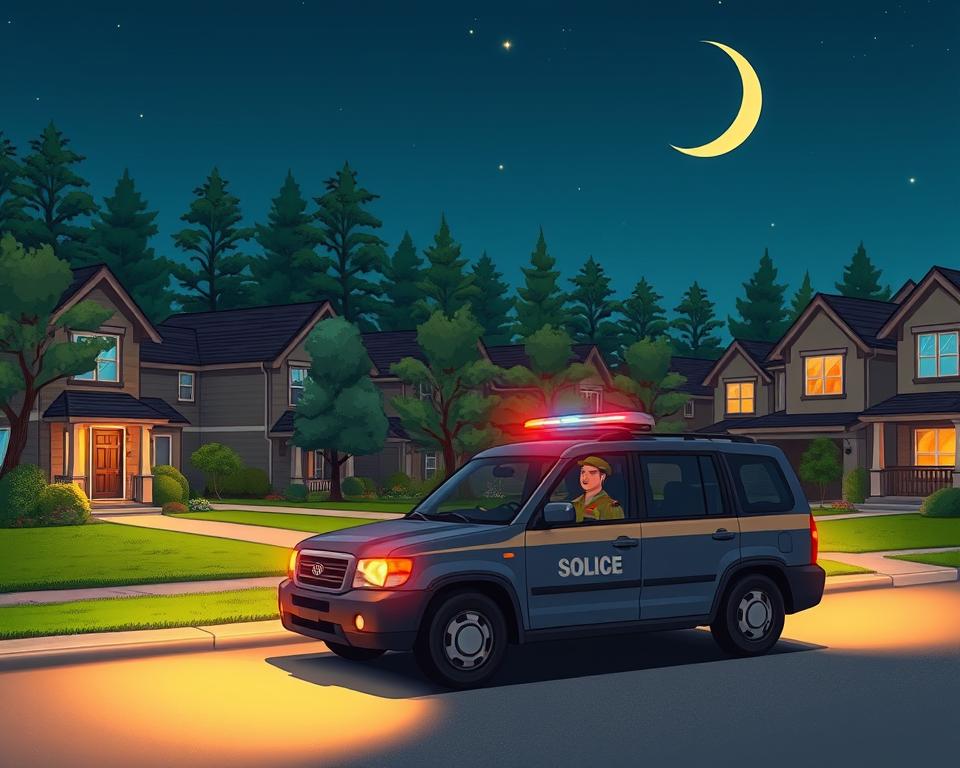Residential Building Security: Improve Occupant Safety
What if the place you call home is not as safe as you think? Apartment complexes confront distinct threats, as research indicates renters endure 33% more burglaries compared to homeowners. This reality renders preventative security steps essential for both property owners and tenants.
Creating secure environments isn’t just about locks and alarms. It’s about fostering trust within your community. Building managers committed to security observe increased tenant loyalty and bolstered reputations. That’s where experts like Divine Protection Services offering construction site security step in, providing customized strategies for today’s issues.
This handbook outlines actionable improvements that truly matter. You’ll learn to combine tech tools with savvy methods—covering entry management systems to community watch initiatives. We’ll cover affordable measures that apply to any property footprint.
Eager to change your complex into a safe haven? Continue reading for practical steps endorsed by security experts. Let’s create reassurance together, one intelligent improvement at a time.

Foundations: The Value of Security in Apartment Buildings
Did you know that feeling safe at home impacts more than just peace of mind? For renters, it shapes daily routines, community trust, and even lease renewal decisions. Indeed, a study reports 40% of dwellers in shared developments are concerned about unauthorized access to shared areas.
What Keeps Tenants Up at Night?
Shared doorways, insufficiently lit parking zones, and obsolete locks dominate renter anxieties. Unlawful entries commonly occur through first-floor windows or unmonitored doors—weak points comprising 62% of incidents in smaller complexes. Contemporary renters now anticipate clear security measures like motion-triggered lighting and 24-hour video coverage.
Security Investments That Yield Returns
Properties with robust protection systems see:
- Tenant loyalty increasing by 28%
- 15% faster unit turnover
- Insurance claims dropping by 31%
Divine Protection Services focuses on building multi-tiered protections, merging intelligent technology with thoughtful design. Their plan encompasses both explicit deterrents and unseen risk zones, spanning from lobby entry stations to basement locker areas.
Up next, we’ll detail how to uncover your building’s specific threats—and convert them into assets.
Carrying Out a Thorough Security Evaluation
Several property overseers neglect hidden dangers until a breach takes place. A detailed evaluation acts like a health checkup for your space—revealing weak spots before they become emergencies. Let’s delve into how to identify hazard spots and develop mitigation plans.
Locating High-Risk Zones
Commence by inspecting the property at multiple times of day. Examine doors for wobbly hinges or antiquated locks. Evaluate windows—reports state 58% of intrusions happen through compromised or unsecured glass. Remember to check closets or utility rooms where visibility can be restricted.
Lighting and Visibility Checks
Poorly lit nooks attract unwelcome actions. Examine outdoor fixtures every month—fading bulbs or non-functioning lights need quick upkeep. Install motion detectors in busy areas such as parking facilities. For monitoring, review camera positions and footage clarity. Can you clearly identify faces at night?
Specialists such as Divine Protection Services employ thermal cameras and entry-pattern analytics during assessments. Their team often finds issues owners miss, like:
- Blind spots behind dumpsters
- Overgrown shrubs near ground-floor units
- Irregular upkeep of fob-access systems
Frequent audits following set checklists confirm all issues are caught. Pair these with expert consultations to build layered protection tailored to your property’s unique layout.
Implementing Effective Access Control Systems
Contemporary entry platforms do more than secure doors—they influence how residents engage with their environment. Studies reveal buildings employing modern access control technology see 73% fewer break-ins than those relying on conventional lock-and-key systems. The optimal system combines tenant convenience with sturdy protection against invaders.
Fob Systems or Code Entry: Which Is Superior?
Physical key fobs are easy to use but can be cloned or misplaced. Keyless systems rely on passcodes or biometric scans, whereas smart locks connect to phone apps for offsite control. Keep these points in mind:
- Keyless solutions lower lost fob issues by 89%
- Smart locks support one-time passcodes for visitors
- Fobs stay favored among elderly residents who like tangible devices
Skilled Installation Improves Outcomes
Divine Protection Services develops tailored plans that mesh with existing surveillance or alarm networks. Their crew oversees each step from electrical work to resident orientation, ensuring flawless implementations. Complexes with expert support experience 40% fewer upkeep problems in year one.
Routinely inspect access logs and upgrade entry protocols. A well-kept setup thwarts threats and nurtures trust—since safety begins at reliable entry points.
Enhancing Surveillance with Security Cameras & Monitoring
Obvious video monitoring functions as deterrent and recorder, curbing intrusions by up to 50% per Urban Institute findings. When tenants notice cameras by entrances, they’re 68% more prone to feel safe. Yet tech by itself doesn’t suffice—it’s the implementation that counts.
Effective Camera Coverage Strategies
Locate cameras to cover clear facial details and license numbers. Prioritize:
- Primary doorways and exits
- Parking area bottlenecks
- Elevators and mailrooms
Divine Protection Services plans “traffic corridors” during deployments. Their crew advises overlapping camera angles to erase blind spots. One client saw a 42% drop in package thefts after adjusting camera heights near delivery zones.
Tips for Integrating Modern Monitoring Solutions
Match 4K cameras with cloud storage for clear low-light images. Motion-activated lights amplify image quality in dim environments. For seamless operation:
- Test lens focus monthly
- Upgrade camera firmware quarterly
- Wipe camera domes each season
“Buildings blending live video with archived footage address incidents 3x faster,” reveals a Divine Protection Services study.
Their team merges surveillance with access control, triggering intelligent alerts on unusual happenings. Regular maintenance checks ensure cameras stay sharp-eyed guardians—rain or shine.
Critical Security Steps for Apartment Complexes
Every click of a reliable lock whispers “you’re protected” to residents. Concrete barriers do more than deny entry—they deliver psychological safety. Studies show properties with upgraded entry points see 74% fewer break-in attempts within the first year.
Contemporary Entry Upgrades
Launch by fitting high-grade deadbolts equipped with anti-pick pins. Strengthened door frames block kick-ins, countering 41% of break-in attempts in shared buildings. For modern upgrades, smart locks offering disposable codes permit delivery personnel entrance without weakening safety.
Divine Protection Services recommends these upgrades:
- Grade 1 industrial-grade locks (triple the strength of home locks)
- Steel-core doors with impact-resistant hinges
- Keyless access platforms that record each entry event
Ongoing upkeep is crucial. Inspect locks every month and swap out worn components at once. One property employing these measures reported 89% fewer burglary incidents in just six months.
“Correct fitting doubles a lock’s strength,” remarks a Divine Protection Services installer. “We’ve supported properties in lowering unauthorized entries by 67% through key upgrades.”
Pair these upgrades with your existing surveillance for stacked security. Remember—strong entry points deter trouble before it starts, keeping communities safe and sound.
Maximizing Safety with Strategic Lighting and Window Protection
Have you noticed how criminals steer clear of brightly lit areas as moths flee light? Research shows 60% of burglaries occur at locations lacking proper lighting. Strategic illumination coupled with strengthened windows crafts a protective barrier that’s difficult to infiltrate.
Smart Lighting to Foil Burglaries
Outdoor lighting needs to push shadows away from doorways. Divine Protection Services recommends motion-activated lights near garages and ground-floor windows—areas where 83% of attempted intrusions occur. Within the building, install ambient hallway lights to dispel shadows without dazzling occupants.
Use these energy-saving suggestions:
- Use dusk-to-dawn sensors for exterior parking fixtures
- Opt for 2700K LED walkway lights to enhance clarity
- Position wall-mounted lamps 8-10 feet up to broaden reach
Inadequate lighting not only benefits intruders—it degrades camera functionality. A Divine Protection Services review discovered cameras in low-light zones record clear footage 70% less frequently. Their staff routinely equip buildings with tempered-glass windows, resisting five times more force than usual panes and minimizing glare for better recordings.
“Multi-tiered lighting reduces fall risks by 44% and discourages intruders at the same time,” says a Divine Protection Services project supervisor.
Organize monthly bulb evaluations and carry out seasonal fixture cleaning. Simple maintenance keeps your defenses bright—literally and figuratively.
DIY Security Enhancements for a Safer Community
Tiny tweaks often lead to significant safety improvements. Renters and property teams can team up using everyday tools—no heavy lifting required. Let’s delve into how easy swaps and collective initiatives forge fortress-like security.
Basic Security Fixes Everyone Can Do
Start with sliding doors—a common weak spot. Cut wooden dowels to fit tracks, creating instant barriers. For glass panes, affix frosted film to conceal valuables yet allow daylight. These $10 modifications block 74% of opportunistic crimes based on crime prevention data.
Implement these occupant-friendly fixes:
- Moveable lockboxes for valuables and papers
- Jam bars that fit under door knobs
- Wi-Fi doorbells sending motion notifications
Storage areas need love too. Employ combo padlocks on storage units and arrange items to highlight vacancies quickly. To deter package theft, position a decoy box stuffed with old paper near the entrance—crooks typically take the first visible box.
Resident involvement is crucial. Begin group messaging threads to flag odd activities. Arrange monthly “security coffee gatherings” where neighbors discuss tips. One community experienced a 53% decline in thefts after inhabitants patrolled parking lots during peak delivery windows.
“DIY solutions work best when paired with professional systems,” says a Divine Protection Services advisor. “We tackle intricate requirements so you can concentrate on everyday precautions.”
Keep in mind—each locked drawer and neighborly greeting fortifies your community. If issues surpass DIY improvements, professionals are prepared to enhance your security.
Merging High-Tech Tools with Traditional Security
Envision your doorstep sending an alert before a package gets swiped from your step. Modern connected devices mesh smoothly with traditional protections, forming reactive security systems attuned to new dangers. Developments leveraging these integrations address incidents 40% quicker while simplifying routine management.
When Tech Meets Peace of Mind
App-controlled locks let residents grant temporary access to dog walkers or repair crews. Detectors identify irregular events—like windows left open in storms—and dispatch immediate alerts. These gadgets excel when linked to unified control hubs, configured by Divine Protection Services’ specialists.
Instantaneous monitoring is critical in emergencies. Picture smoke detectors causing doors to automatically open for firefighters. Or moisture sensors shutting off water lines before flooding impacts multiple units. Systems such as eufy HomeBase deliver:
- Protected video cloud storage
- Personalized monitoring zones
- Backup batteries for blackouts
Fire protection advances as well. Infrared cameras detect hot appliances, and smart vents limit smoke dispersion. A facility lowered false alerts by 68% by choosing thermal triggers instead of typical smoke sensors.
“We integrate modern tech with your current setup—no tear-out required,” notes a Divine Protection Services engineer. “Residents keep familiar locks while gaining app-based controls.”
Cloud-centric management puts all controls at your fingertips. Review entry logs during disputes or activate extra cameras during holidays. With skilled configuration, these systems appear less like gadgets and more like dependable neighbors—always alert, never invasive.
Wrapping Up: Ensuring Lasting Apartment Safety
Real security begins with doors that only admit authorized individuals. By uniting routine assessments with innovative tech, properties build spaces where tenants excel. Ongoing upkeep of access controls and lighting keeps your property well ahead of threats.
Remember these crucial points:
- Test locks and cameras monthly
- Update emergency contact numbers quarterly
- Evaluate parking area visibility with each season
Collaboration makes safety sustainable. Collaborate with residents to report faulty lighting or suspicious boxes. Collaborate with consultants like Divine Protection Services for annual security reviews—their thermal imaging identifies concealed flaws standard checks neglect.
Keep in mind: multiple layers of security mix homeowner vigilance with expert systems. A door jam device excels when backed by cloud-synced access logs. Motion detectors work best when neighbors relay live alerts through neighborhood apps.
Kick off today by touring your property with a rejuvenated outlook. Spot overgrown vegetation by ground-floor windows or dull exit signage. Little measures accumulate into steadfast confidence—for your community now and going forward.
Frequently Asked Questions
How do I strengthen entry doors without extensive remodeling?
Kick off by strengthening your doors with deadbolts, strike plates, and peepholes. For a high-tech option, use smart locks or keyless entry that needs no structural modifications. Even tiny fixes can keep intruders away.
How do I choose between smart locks and traditional key fobs?
Smart locks allow immediate app-based control—perfect for properties with short-term leases or steady tenant change. Key fobs work well for communities prioritizing simplicity. Assess your budget and tenant needs—brands like Schlage or Yale offer reliable options for both approaches.
Which locations offer ideal camera coverage?
Focus on high-traffic zones like entrances, parking areas, mailrooms, and shared spaces. Make sure cameras capture blind zones by staircases or storage rooms. Adjust cameras to record faces yet protect privacy—systems like Ring or Arlo, offering motion alerts, are common for continuous oversight.
Does improved lighting actually lower crime rates?
Absolutely! Bright lighting outside wards off intruders. Place motion-sensing floodlights around alleys or trash areas, and provide steady light on pathways. Indoors, hallway LED fixtures banish shadowy spots where unauthorized actions could occur.
How can renters improve security on their own?
Occupants can fit window sensors, use door jammers, or deploy temporary systems like SimpliSafe. Urge neighbors to flag odd behaviors and trim bushes near windows regularly. Minor steps build a communal “watchful neighbors” approach.
What is the recommended frequency for rotating entry codes or fobs?
Rotate codes quarterly or after a tenant moves out. For properties with rapid turnover, select systems like Kisi or Salto that support remote deactivation. Routine updates decrease the risk of copied credentials or intrusions.
Should I add glass break detectors?
Certainly. These sensors register glass breaking and send alarms right away, increasing security for ground-floor units and lobby windows. Combine them with security window film to slow entry—providers like ADT bundle them in tailored plans.
What’s the easiest way to manage package theft?
Create locked parcel areas with unique codes or opt for Luxer One smart locker solutions. For smaller properties, designate a monitored pickup area with Amazon Hub. Visible signage additionally advises delivery personnel against leaving parcels unattended.
In what ways does tech aid in crises?
Smart smoke detectors like Nest Protect send alerts to phones, while water leak sensors prevent property damage. Integrate devices with a central hub for real-time alerts, and ensure systems have battery backups in case of power outages.
Should communities hire onsite security guards?
It depends on location and budget. High-risk areas benefit from patrols, while others might use virtual guards via cameras. Services like Divine Protection offer tailored solutions, blending live monitoring with rapid response teams for cost-effective coverage.


